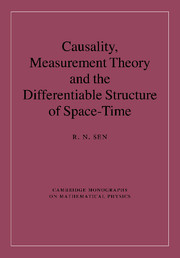Book contents
- Frontmatter
- Contents
- Preface
- Acknowledgements
- To the reader
- Prologue
- Part I Causality and differentiable structure
- Introduction to Part I
- 1 Mathematical structures on sets of points
- 2 Definition of causality on a structureless set
- 3 The topology of ordered spaces
- 4 Completion of ordered spaces
- 5 Structures on order-complete spaces
- Part II Geometrical points and measurement theory
- Mathematical appendices
- List of Symbols for Part I
- References
- Index
1 - Mathematical structures on sets of points
Published online by Cambridge University Press: 04 August 2010
- Frontmatter
- Contents
- Preface
- Acknowledgements
- To the reader
- Prologue
- Part I Causality and differentiable structure
- Introduction to Part I
- 1 Mathematical structures on sets of points
- 2 Definition of causality on a structureless set
- 3 The topology of ordered spaces
- 4 Completion of ordered spaces
- 5 Structures on order-complete spaces
- Part II Geometrical points and measurement theory
- Mathematical appendices
- List of Symbols for Part I
- References
- Index
Summary
Every student of physics is familiar with the Gibbs paradox, and its resolution by ‘correct Boltzmann counting’. The paradox arises because identical particles in classical physics are assumed distinguishable; the question of how they are to be distinguished is not asked. The resolution, correct Boltzmann counting, is equivalent to the assumption that even in classical mechanics, two point-particles with the same mass cannot be distinguished from each other.
The opposite is true in set theory. Take the assembly of geometrical points that constitute an open interval on a straight line, and recall that in Euclidean geometry a point has no structure. Now perform a thought-experiment in which two points are pulled out at random from the interval and shown to an observer in the next room. There is no way in which the observer can tell one from the other. However, admitting two identical objects in a set is a recipe for disaster (see the example on page 242); if one does, then it becomes impossible to define the notion of a function in a sensible manner. A set, in mathematics, has to be a collection of distinct objects, considered as a single entity.
How, then, is one supposed to understand ‘the set of points that constitute the real line’ or the two-dimensional plane? The short answer is: exactly as Gibbs understood an assembly of n classical point-particles – distinguishable. Familiarity with quantum mechanics may have made it counterintuitive to today's physicist, but it was clearly not counterintuitive to Gibbs, and does not appear to be counterintuitive to mathematicians.
- Type
- Chapter
- Information
- Publisher: Cambridge University PressPrint publication year: 2010



